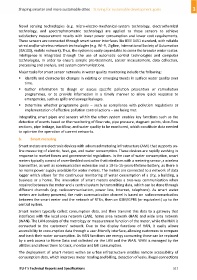Page 527 - Shaping smarter and more sustainable cities - Striving for sustainable development goals
P. 527
Novel sensing technologies (e.g. micro‐electro‐mechanical‐system technology, electrochemical
technology, and spectrophotometric technology) are applied to these sensors to achieve
satisfactory measurement results with lower power consumption and lower cost requirements.
These sensors are connected through smart sensor interfaces like IEEE 1451 standard, with reliable
wired and/or wireless network technologies (e.g. Wi‐Fi, ZigBee, International Society of Automation
(ISA100), mobile network). Thus, the system is easily expandable to cover the broader water sector.
Intelligence is integrated through the use of automatic control technologies and computer
technologies, in order to ensure sample pre‐treatment, sensor measurement, data collection,
processing and analysis, and system communications.
Major tasks for smart sensor networks in water quality monitoring include the following:
Identify and characterize changes in existing or emerging trends in surface water quality over
time.
Gather information to design or assess specific pollution prevention or remediation
programmes, or to provide information in a timely manner to allow quick response to
emergencies, such as spills and sewage leakages.
Determine whether programme goals – such as compliance with pollution regulations or
implementation of effective pollution control actions – are being met.
Integrating smart pipes and sensors within the urban system enables key functions such as the
detection of events based on the monitoring of flow rate, pipe pressure, stagnant points, slow‐flow
sections, pipe leakage, backflow, and water quality to be monitored, which constitute data needed
to optimize the operation of current networks.
b. Smart metering
Smart meters are electronic devices with advanced metering infrastructure (AMI) that supports on‐
line measuring of electric, heat, gas, and water consumption. These devices are rapidly evolving in
response to market forces and governmental regulations. In the case of water consumption, smart
meters typically consist of an embedded controller that interfaces with a metering sensor, a wireless
transmitter, as well as communication extension and a 10‐to‐15‐years‐lifetime battery, as there is
no mains power supply available for water meters. The meters are connected to a network of data
logger which allows for the continuous monitoring of water consumption of a city, a building, a
business or a home. The innovation of smart meters enables a two‐way communication when
required between the meter and a central system by transmitting data, which can be done through
different channels (e.g. radiocommunication, power line, Internet, telephone). As smart water
meters are battery powered, the main communication channel is based on radiocommunication
between the smart meter and the network of RTUs, then on GSM/GPRS (or equivalent) up to the
central system.
Smart meters typically collect consumption data, and then transmit this data to a gateway that
interfaces with the local area network (LAN), home area network (HAN) and wide area network
(WAN). The LAN consists of the metrology or measurement function of the meter, while the HAN is
connected to the customers' network. Due to the display functions of HAN, it easily allows
accessibility to consumption data through a user‐friendly interface, allowing customers to compare
and track their water consumption. As HAN functions are energy consuming those can be replaced
by a web access to Home Data and collected via the LAN and the WAN. WAN is managed by the
utilities and allows them to track, monitor and bill consumption.
The deployment of smart meters within an urban infrastructure enables remote accessibility of
consumption data, which improves meter reading and billing, detection of leaks, illegal connections
ITU‐T's Technical Reports and Specifications 517

